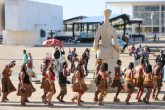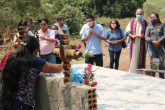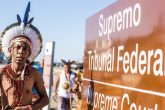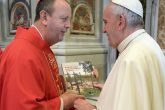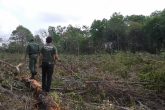Newsletter 901: Community of Kaingang People retake land in capital of Rio Grande do Sul
On Wednesday evening the 17th of February, a group of 15 families of the Kaingang people retook an area of land named Morro Santana, in the Barro Santana, in Porto Alegre, capital of the state of Rio Grande do Sul. These families live on the peripheries of the capitol and for many years have demanded that FUNAI (National Foundation of Indigenous Affairs) constitute a Working Group (GT- Grupo de Trabalho) to conduct the studies for identification and demarcation of the area.
According to Eli Kaingang, an indigenous leader in the region, the occupation was tranquil and with the clear objective of demanding a right of the Kaingang people: access to land. “The occupation was well considered and well planned, it is based on years of research and study about the old residents of the area. The question came to the attention of the people by means of a journalist who published an article saying that the land had been occupied by our people and was originally ours”, he declared.
Academic research
The area occupied by the Kaingang is under the domain of the Federal University of Rio Grande do Sul (UFRGS) and located near the municipalities of Alvorado and Viamão. Researchers from the university linked to the biology, archeology and anthropology departments developed studies pointing to the land in question as being used by the Kaingang for decades. Morro Santana makes up part of the areas that indigenous families traditionally occupy for the management and collection of materials such as cipó plants and taquara bamboo, utilized as prime material in the creation of artisan work and baskets.
In 2008 FUNAI held several meetings with leaders of the Kaingang people in Rio Grande do Sul, especially in Porto Alegre and Passo Fundo. During these meetings indigenous leaders made known their relationship to the areas they want demarcated. Among those areas indicated by the Kaingang were: Morro do Osso, Lomba do Pinheiro, Morro Santana, São Leopoldo, Estrela, Lajeado and Farroupilha. The representatives of the indigenist agency made the commitment that by July 2009 they would create Working Groups with the objective of conducting studies of identification of these areas.
Fundamental rights
According to indigenous leaders, the retaking of Morro Santana has the objective of marking a firm position in defense of their rights, and with this the Kaingang intend to expedite the creation of working groups by the FUNAI for proceeding with the studies in the areas claimed by them for decades. “We are tired of waiting, this is why we resolved to occupy the area demanding provisions by FUNAI. We demand respect for our rights to land as well as the creation of public policies specifically in health and education”, said Eli.
The land where this Kaingang community lives, indigenous territory Nonoai, located in the north of the state became insufficient for sustaining life and the subsistence of the families. The area was demarcated in 1910, when circa 400 indigenous people lived in the region. Today there are nearly ten thousand people. The lack of space for planting and other forms of maintenance of indigenous physical and cultural health caused many families to move to the city, which alienated the children and youths from parts of the customs of their people.
The eldest still firmly maintain traditions, such as language and practice of rituals, even in the urban centers. The youths, through coexistence with non-indigenous and lack of specific and differentiated study have become ever more distant from traditional indigenous culture, hardly speaking the mother tongue and losing nearly all of their rituals.
Relationship with the land
Kaingang from all of the areas live in urban centers and maintain a firm relationship with the environment, they depend on it for their physical, spiritual and economic survival. The areas claimed are those necessary for survival and maintaining the culture of this people. In these lands the families celebrate life, realize rituals, collect seeds and traditional remedies, develop educational practices for the children and youths, in the perspective of strengthening Kaingang culture.
Urban space is today integrated into the Kaingang way of living and in a dynamic form, they maintain a direct relationship by means of commercialization of their products, in the struggle to guarantee rights to health, education and for urban spaces where they succeed in establishing their labor bank. The hundreds of indigenous Kaingang families who live in the urban centers succeed in living their culture dynamically by means of speaking their own language, by rituals of birth, marriage, eating habits, of celebrations including rites of passage and rituals in death.
Porto Alegre, 18 February of 2010
Cimi Staff South Porto Alegre


